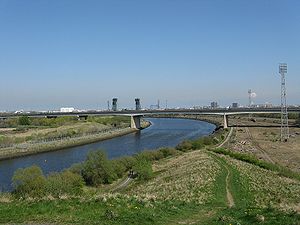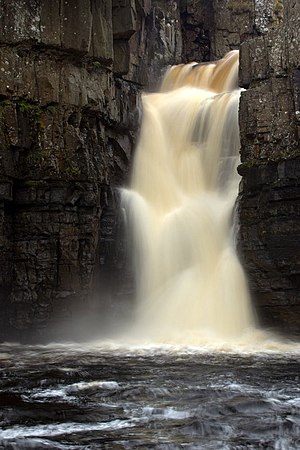River Tees
The River Tees marks the boundary of Yorkshire and County Durham from close by its source all the way to the sea.
The Tees rises on the eastern slope of Cross Fell in Cumberland, at the watershed between the east and west coasts. From there it flows eastwards for 85 miles to reach the North Sea between Hartlepool, County Durham, and Redcar, Yorkshire.
Contents
Geography
The river drains an area of 708 square miles and subsumes no important tributaries. Soon after trickling off Cross Fell, the Tees leaves Cumberland and forms the boundary between Westmorland and County Durham. Soon though it marks County Durham to the north and the North Riding of Yorkshire to the south and its natural course does not leave the boundary until it falls into the sea.
The upper part of the river is known as Teesdale, which has a desolate grandeur, surrounded by hills of the Pennines, some exceeding 2,500 feet, and bleak moorland. In the headwaters is the Cow Green Reservoir constructed to store water to be released in dry conditions to supoport industrial need for water on Teesside.[1]
A succession of falls or rapids, where the river traverses a series of hard black basalt rocks, is called "Cauldron Snout". It is from immediately below this that the Tees forms the boundary between the Durham and Yorkshire. The dale becomes bolder below Cauldron Snout, and trees appear, contrasting with the broken rocks where the water dashes over High Force.
The scenery becomes gentler and more picturesque as it descends past Middleton-in-Teesdale. This locality has lead and ironstone resources. The ancient town of Barnard Castle, Egglestone Abbey, and Rokeby Hall, well known through Sir Walter Scott's poem, are each passed; and then the valley begins to open out, and traverses the rich plain east and south of Darlington in sweeping curves.
The course of the valley down to here has been generally east south east, but it now turns northeast and, nearing the sea, becomes an important commercial waterway, with the ports of Stockton-on-Tees and Middlesbrough on its banks. It passes through the Tees Barrage between these ports, turning tidal downstream from the barrage.
Teesport is built on reclaimed land on the south side of the Tees estuary below Middlesbrough.
Seal Sands
Before the heavy pollution of the Tees by industry, the flats at Seal Sands in the estuary were home to Common Seals and Grey Seals. For around 10 years these species were absent from the estuary due to pollution. But recently water quality has improved dramatically, and the seals can once again be seen in the estuary and on the flats at Seal Sands.[2] The Seal Sands area is now designated as the Teesmouth National Nature Reserve.
Alterations

In the early 19th century the river was straightened, thus saving money and time in navigation. Between Stockton-on-Tees and Middlesbrough, the river previously meandered first south and then north of its current channel. Two "cuts", known as the Mandale Cut and the Portrack Cut were made to straighten its course. Before these cuts were made, the journey by sailing barge from Thornaby to Middlesbrough, allowing for tides and other factors, could take as long as the journey from the mouth of the Tees to London. The Mandale Cut was the shorter of the two, at about 200m, with the Portrack Cut being considerably longer, although the northern meander it removed was smaller than the southern meander. Neither meander is visible today, except for the flow of Stainsby Beck into a waterway which is marked on maps first as "The Fleet" and then "Old River Tees". The current Tees Barrage is close to the site of the Mandale Cut.
Since the cuts were made, the river has continued to undergo alterations on its bed and banks to make it deeper and more navigable. The channel has been made considerably narrower by dumping ship's ballast and ironworks slag along the former banks, increasing the scouring due to its natural flow. Maps made before 1900[3] show that between Stockton and Middlesbrough the river flowed in a channel up to 330 yards wide in places, with many shoals and sandbars. The modern channel varies between 110 and 220 yards or even a bit more.
Legends and folklore
Peg Powler is a hag in English folklore who is said to inhabit the River Tees.
In popular culture
The River Tees was featured in the television series Seven Natural Wonders as one of the wonders of the North.
Outside links
References
- ↑ Tees at Barnard Castle in Dales Area - Artificial influences
- ↑ "Natures World" Natures World Tees Feature
- ↑ The History of the River Tees in Maps, 3rd. Ed. (2001), D.W. Pattenden, published by Cleveland and Teesside Local History Society ISBN 0-9507199-6-X
